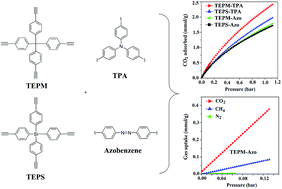Microporous organic polymers based on tetraethynyl building blocks with N-functionalized pore surfaces: synthesis, porosity and carbon dioxide sorption†
Abstract
A series of microporous organic polymers (MOPs) based on tetraethynyl monomers such as tetrakis(4-ethynylphenyl)methane and tetrakis(4-ethynylphenyl)silane was synthesized via conventional Sonogashira–Hagihara coupling reaction. The resulting MOPs were characterized by thermogravimetric analyses, IR-spectra, scanning electron microscopies, and the Brunauer–Emmett–Teller (BET) method. The incorporation of triphenylamine or azobenzene moieties into the polymer skeleton increases the number of electron donating basic nitrogen sites in the porous frameworks. Thus, these MOPs could exhibit efficient adsorption of Lewis acidic CO2 molecules and display good CO2-over-N2 selectivity. The triphenylamine-based polymer, TEPM-TPA, shows a high BET specific surface area up to 1072 m2 g−1 with a moderate CO2 uptake capacity of 2.41 mmol g−1 at 273 K and 1.13 bar. As for separation of CO2, both TEPM-Azo and TEPS-Azo exhibit relatively high CO2-over-N2 selectivities of 70.8 and 64.7 at 273 K, respectively, due to the N2-phobic feature of azo-based polymers.


 Please wait while we load your content...
Please wait while we load your content...